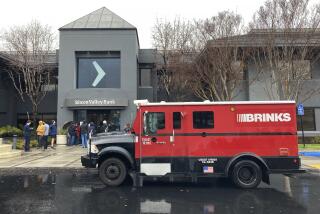Water Plant Records Dip Into San Diego History
Most people take things like cold showers and tap water for granted.
But not 71-year-old Marco Thorne, who has spent the better part of his retirement trying to piece together the history of water development in San Diego County.
Four years ago Thorne, bored with retirement life, started looking for something to occupy his spare time after leaving his position as director of the San Diego Public Library in 1978.
On a tip from San Diego ombudsman George Story, Thorne went to the San Diego Water Utility’s Alvarado Filtration Plant, where he found a confusing stack of documents that might have sent the average person back to the comforts of retirement living.
“If Marco Thorne hadn’t come out here we were going to take this stuff to the dump,” said Bradford D. Snow, Alvarado’s lead filtration operator.
But to Thorne, a career librarian with a master’s degree in California history, the records posed a challenge.
Since the initial discovery in 1979, Thorne has spent three to four days a week in the plant’s damp basement filing, indexing and alphabetizing the documents he has collected from the city’s three filtration plants.
Thorne’s collection includes ledgers filled with billing records of San Diego’s settlers, a set of handmade, ornate maps on parchment and a series of documents from the 1800s predicting San Diego’s growth and water needs.
“These men (water and hydraulic engineers) were the real city planners,” Thorne said. “In those early years, we forget that they not only had to figure on people but also animals,” he added.
In a tiny and poorly lit storage room in the basement’s filtration plant, Thorne has boxes of letters, shelves full of ledgers and volumes of scrapbooks left by a hydraulic engineer who has come to be one of his heroes.
According to Thorne, Hiram Newton Savage stood nose to nose with San Diego politicians in the early 1900s after discovering a need to augment the city’s water supply with Colorado River water.
“If it weren’t for him, I don’t think we would have had the water we enjoy now,” Thorne said.
San Diego imports 90% of its water, most of it from the Colorado River aqueduct.
But not everyone gets excited about the history of water development.
“I still don’t know what all this junk is,” Snow said, referring to a five-foot pile of books and boxes. “I keep calling it junk but I guess it’s really historical documents,” Snow added apologetically.
Thorne has used these documents to put together what Alvarado plant director Allan Langworthy calls one of the best histories of San Diego he has seen.
For instance, Thorne found that officials had to purchase the sand needed for the city’s rapid sand filtration system from a remote beach in Cape May, New Jersey. California beaches produced rough, scratchy sand that could not compare with the smooth sand found along the New Jersey shore.
He also found the original payroll receipts for a hot summer day’s work when 16 horse carts moved eight filtration tanks down El Cajon Boulevard to the Lower Otay plant near the border after the city bought out the Southern California Mountain Water Company in 1914.
After four years and hundreds of hours of fruitful research, Thorne has decided to leave his work to return to the retirement he originally sought to avoid.
“Things change. I’ve gone as far as I could as a volunteer,” Thorne said.
Thorne hopes his collection won’t be forgotten but doubts the collection will ever be publicly displayed.
“I hope some college student stumbles onto this stuff. It would make a great doctoral dissertation,” Thorn said.
More to Read
Start your day right
Sign up for Essential California for news, features and recommendations from the L.A. Times and beyond in your inbox six days a week.
You may occasionally receive promotional content from the Los Angeles Times.






